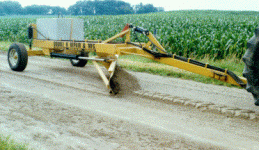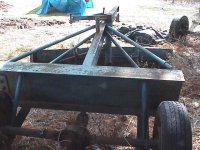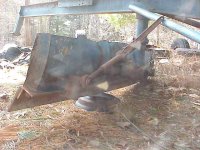You are using an out of date browser. It may not display this or other websites correctly.
You should upgrade or use an alternative browser.
You should upgrade or use an alternative browser.
Idle hands.........
- Thread starter wroughtn_harv
- Start date
- Views: 7292
More options
Who Replied?
/ Idle hands.........
#41
Anonymous Poster
Epic Contributor
- Joined
- Sep 27, 2005
- Messages
- 29,678
A couple things, first, you don't need downpressure at the hitch point of the grader, you need major weight at the wheel end, or you will pick the wheels off the ground QUICK. Notice the big concrete block on the commercial version.
Secondly, length is very important. Mine is 13'6" from hitch to center of wheels. The length of the machine does a lot to minimize washboarding.
A lot of what I did in building mine was governed by what was on the scrap pile, nothing on it came from anyplace else, other than the pin that keeps the rotation locked in place.
Don't get hyper about adjusting from the seat, because the only adjustment you tend to make once you are grading is up/down. My blade rotation is 6 positions, held in place by a pin, and the tilt angle on the blade is accomplished by a screw type load binder.
This machine has moved a lot of material, over 10 years, and hasn't had any modification. I can cut a swail in red clay with it, as long as the clay isn't baked out. The only modification I'd make, if I had the material, would be to add more weight at the wheel end.
Secondly, length is very important. Mine is 13'6" from hitch to center of wheels. The length of the machine does a lot to minimize washboarding.
A lot of what I did in building mine was governed by what was on the scrap pile, nothing on it came from anyplace else, other than the pin that keeps the rotation locked in place.
Don't get hyper about adjusting from the seat, because the only adjustment you tend to make once you are grading is up/down. My blade rotation is 6 positions, held in place by a pin, and the tilt angle on the blade is accomplished by a screw type load binder.
This machine has moved a lot of material, over 10 years, and hasn't had any modification. I can cut a swail in red clay with it, as long as the clay isn't baked out. The only modification I'd make, if I had the material, would be to add more weight at the wheel end.
OkieG
Veteran Member
Franz,
Exactly! Your comments were what I was thinking. I was also thinking, the best way allow the tractor to pitch and roll over the dips and lumps and affect the grader as little as possible would be to tow it with a hitch ball rather than a direct connection to the 3ph.
Scrap steel has been collecting to use as extra weight between the wheels and blade. My biggest hurdle will be to try and make the blade. I don't have a back-blade and don't want to spend much on this project. One of the drawbacks of this kind of implement is it's hard to trailer if needed somewhere else. So, I suspect that once my yard is "flat" the grader will mostly just sit.
OkieG
Exactly! Your comments were what I was thinking. I was also thinking, the best way allow the tractor to pitch and roll over the dips and lumps and affect the grader as little as possible would be to tow it with a hitch ball rather than a direct connection to the 3ph.
Scrap steel has been collecting to use as extra weight between the wheels and blade. My biggest hurdle will be to try and make the blade. I don't have a back-blade and don't want to spend much on this project. One of the drawbacks of this kind of implement is it's hard to trailer if needed somewhere else. So, I suspect that once my yard is "flat" the grader will mostly just sit.
OkieG
Anonymous Poster
Epic Contributor
- Joined
- Sep 27, 2005
- Messages
- 29,678
Mine pulls from a Lunette Eye (Mack U bolt) because I have a pintle hook on the back of my Yanmar. A ball hitch would work equally well, but Mack U bolts are free, and I love free.
Weight really needs to be over, or just behind the wheels, because very little weight is necessary to keep the blade down, strange as that may seem.
My blade is a 7' snowplow blade that was involved in an incident with a hydrant. I cut it so it is about 12" high.
As far as towing over the road, since I used a rear end from a Duster for the axel, I could accomplish road towing by extending the goosneck drawbar, were I inclined to take it over the road. The blade itself could be easily configured to paralell the beam.
Weight really needs to be over, or just behind the wheels, because very little weight is necessary to keep the blade down, strange as that may seem.
My blade is a 7' snowplow blade that was involved in an incident with a hydrant. I cut it so it is about 12" high.
As far as towing over the road, since I used a rear end from a Duster for the axel, I could accomplish road towing by extending the goosneck drawbar, were I inclined to take it over the road. The blade itself could be easily configured to paralell the beam.
Attachments
Anonymous Poster
Epic Contributor
- Joined
- Sep 27, 2005
- Messages
- 29,678
Taylortractornut
Elite Member
- Joined
- Mar 27, 2002
- Messages
- 2,921
- Location
- Iuka Mississippi USA
- Tractor
- 3550 Fard Backhoe and a 1948 Farmall Cub,
Harv does JCB offer a backhoe for your machine? I saw one that attaches to the front frame of the skid loader and the arms stayed in the air. You could bolt the grader neck to the front of your machine like the frame mounted hoe and run a linkage from the loader arm to the lift on the grader drawbar. Then use a linkage from the bucket to tilt the blade. one thing would be to mount/clamp a linkage to the arm then mount one to the quicktach for the tilt. Kinda hard for me explain Takecare Taylor Lambert
OP
wroughtn_harv
Super Member
I can use anything they've made for Bobcat or Case on my JCB.
I have standard auxillary hydraulics and then I have the high flow circuit, puppy gets after it like a big dawg. /forums/images/graemlins/grin.gif
I have standard auxillary hydraulics and then I have the high flow circuit, puppy gets after it like a big dawg. /forums/images/graemlins/grin.gif
Taylortractornut
Elite Member
- Joined
- Mar 27, 2002
- Messages
- 2,921
- Location
- Iuka Mississippi USA
- Tractor
- 3550 Fard Backhoe and a 1948 Farmall Cub,
I couldn't remember wheter or not it had the holes in the frame for a solid mount hoe. Some of the larger hoes have to connect to the frame of the machine instead of the arms. Im trying to find a picture of the grader that bolts on the front of the Skidsteers frame insted of the lift arm.



